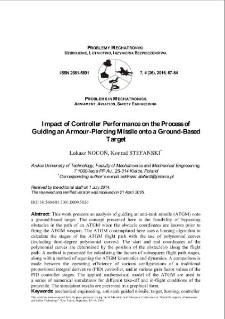Our Digital Library contains 1 868 digital objects
Object
Title: Impact of Controller Performance on the Process of Guiding an Armour-Piercing Missile onto a Ground-Based Target
Alternative title:
Wpływ typu regulatora na proces naprowadzania przeciwpancernego pocisku rakietowego na cel naziemny
Contributor:
Abstract:
Abstract: This work presents an analysis of guiding an anti-tank missile (ATGM) onto a ground-based target. The concept presented here is the feasibility of bypassing obstacles in the path of an ATGM when the obstacle coordinates are known prior to firing the ATGM weapon. The ATGM contemplated here uses a homing algorithm to calculate the stages of the ATGM flight path with the use of polynomial curves (including third-degree polynomial curves). The start and end coordinates of the polynomial curves are determined by the position of the obstacle(s) along the flight path. A method is presented for calculating the factors of subsequent flight path stages, along with a method of equating the ATGM kinematics and dynamics. A comparison is made between the operating efficiency of various configurations of a traditional proportional integral derivative (PID) controller, and at various gain factor values of the PID controller stages. The applied mathematical model of the ATGM are used in a series of numerical simulations for different take-off and in-flight conditions of the projectile. The simulation results are presented in a graphical form.
Place of publishing:
Warszawa
Publisher:
Date created:
Date submitted:
Date accepted:
Date issued:
Extent:
Identifier:
oai:ribes-88.man.poznan.pl:2295
Call number:
Electronic ISSN:
Print ISSN:
Language:
Rights holder:
Starting page:
Ending page:
Volume:
Keywords:
mechanical engineering, anti-tank guided missile, target, homing, controller
Object collections:
Last modified:
Jul 24, 2025
In our library since:
Jul 24, 2025
Number of object content hits:
0
All available object's versions:
https://ribes-88.man.poznan.pl/publication/2595
Show description in RDF format:
Show description in OAI-PMH format:
| Edition name | Date |
|---|---|
| Impact of Controller Performance on the Process of Guiding an Armour-Piercing Missile onto a Ground-Based Target | Jul 24, 2025 |
Objects Similar
Konrad STEFAŃSKI
Konrad STEFAŃSKI
Konrad STEFAŃSKI Marta GRZYB
Konrad STEFAŃSKI Marta GRZYB

